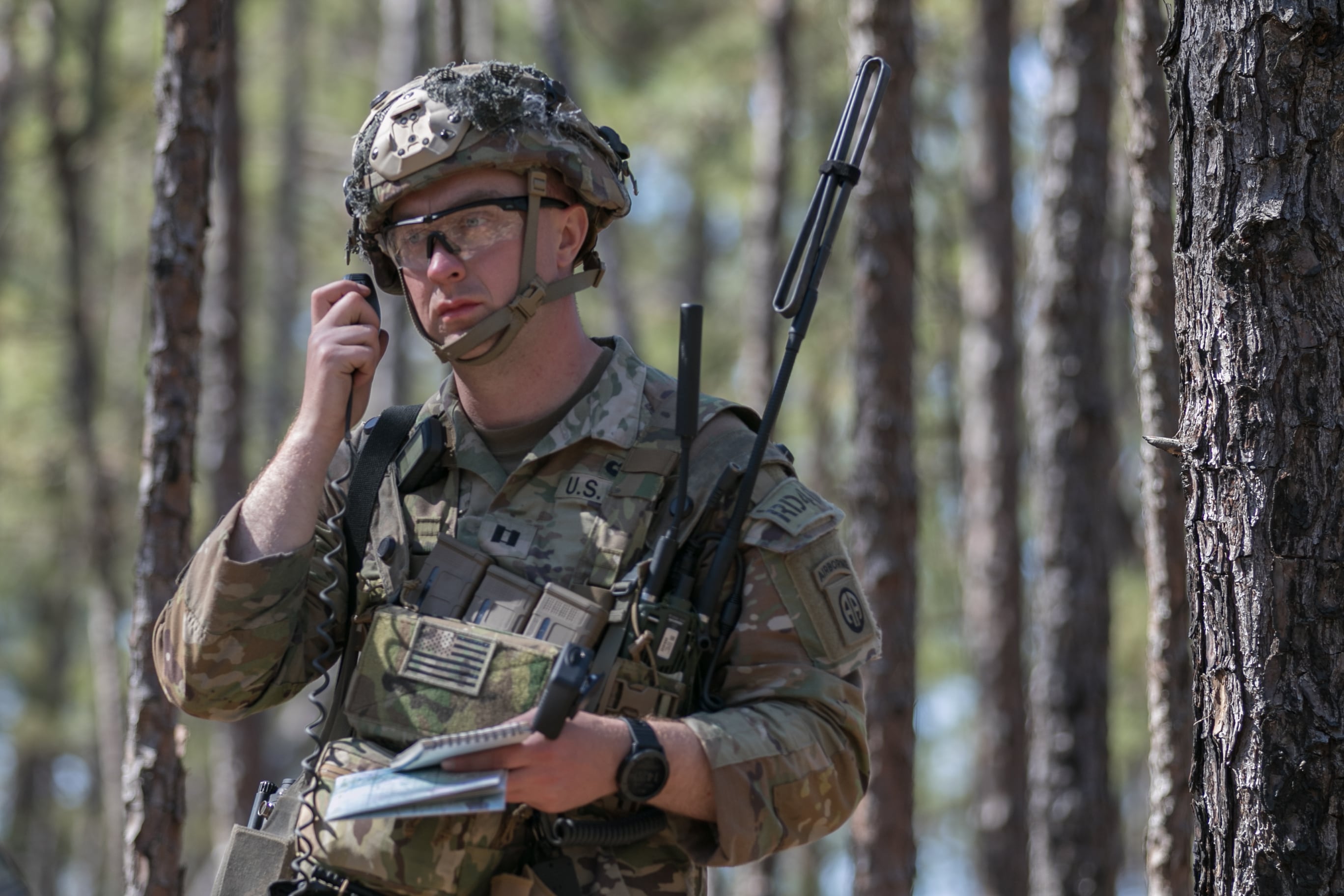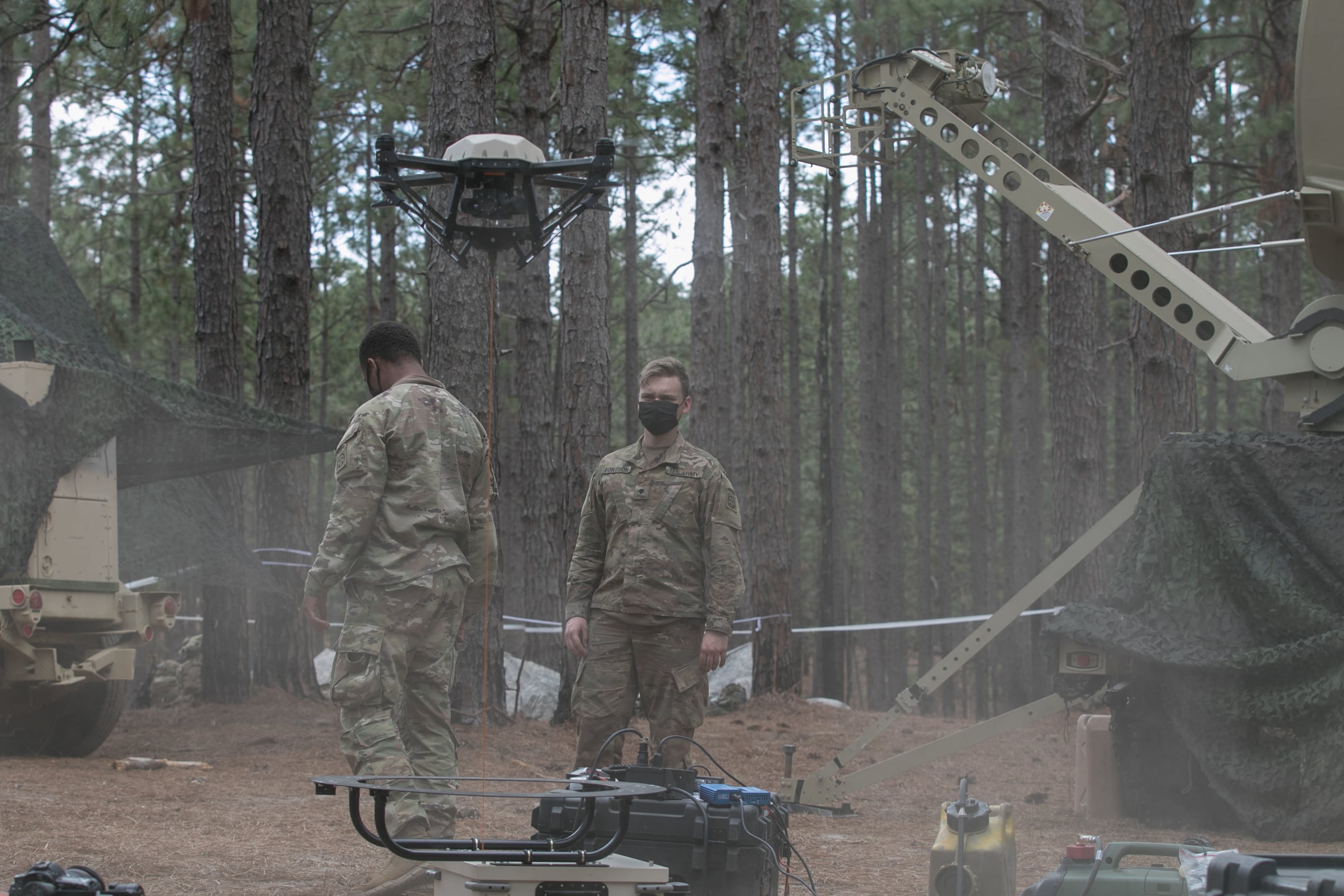FORT POLK, La. — Paratroopers testing the Army’s latest communications equipment jumped into a sprawling field surrounded by dense woods and moved north upon landing in an effort to secure the area.
Significant equipment improvements allowed the 1st Brigade, 82nd Airborne Division to communicate clearly across greater distances than in the past — up to about 28 miles, said Lt. Col. Andy Harris, commander of the brigade’s 1st Battalion, 504th Parachute Infantry Regiment.
Mapping on hardened cell phones, another new capability, showed teammates’ locations in near real time across the training environment’s miles of fields and forests. The devices gave team leaders new options to text if needed or follow the mission route on their screens instead of using paper maps alone.
“It’s 100 times better,” Harris said of the equipment. “If you can establish the mesh network and [connected] bubbles throughout, you can communicate as far as you want as long as those networks are established.”
The exercise, a regular training rotation last month at the Joint Readiness Training Center at this installation in rural Louisiana, was the culmination of three years of work to collect more soldier input and speed up how the Army procures and fields the equipment.

The test was the first time an entire brigade used the updated radios, tactical phones and network gear the Army will field to units this year. It will also help determine millions in acquisitions for years to come.
For example, the Army’s budget request last year for commercial off-the-shelf IT gear was about $94 million, which includes the bulk of its Integrated Tactical Network gear, such as gateways and high-frequency and single-channel radios. The communications kits, part of the ITN, include a variety of additional items dispersed across many budget lines.
The exercise will help the Army make final decisions about what gear — and how much — to send out this year. The Army Test and Evaluation Command also used the demonstration to evaluate whether the new design is survivable and effective.
The Army hasn’t had soldiers’ insights from large-scale rotations in the past, said Maj. Gen. Peter Gallagher, director of the Army Network Cross-Functional Team.
“As we’ve scaled this up, this is really the first opportunity at the brigade level to shake this system out at scale with a force-on-force active enemy in an environment like this,” he said in a secluded field in the middle of the training range, the site of a major command post the day prior. “Tremendous opportunity for getting soldier and leader feedback on the performance … shaping our iterative improvement of this network.”
The modernized equipment provides units with speed and range needed to defeat advanced adversaries in a multidomain battlefield, officials said.
“This is all about speed and range. You start getting after what we want to do for decisive operations, decisive decision-making. We want to get after sensor-to-shooter,” said Brig. Gen. Robert Collins, program executive officer for command, control, communications-tactical. “How do we do that quickly at speed, how do we extend the range? … I think this fundamentally is a game-changer and allowing this airborne unit to be able to extend across those areas of speed and range.”
Another important upgrade is that the equipment set includes multiple, resilient communications options with more hardened waveforms. Previously, soldiers had limited options if communications failed or were jammed.
The technology provides them a PACE plan: primary, alternate, contingency and emergency, Gallagher said. “This gives them options, which I think is good. Give them the resilience to fight through what an adversary might throw at them.”
The Army started to modernize key pieces of its network after internal and external reviews three to four years ago found its network would not withstand a sophisticated threat. The service is adopting new technology alongside legacy systems, using various training events to collect soldiers’ opinions to adjust the equipment.
The kits fielded this year are Capability Set ’21, which creates a baseline to which the Army will add equipment. The service plans incremental delivery of new capability sets every two years.
What was learned?
Army leaders gleaned some immediate feedback from the exercise, including a need to simplify the network for pre-mission deployment. The system is somewhat complex to get ready to deploy, involving technical radio programming. Though once up and running, the system is much easier to use.

Part of the fix involves automated planning tools the program team is reviewing. There are larger questions for the Army about what type of training on the equipment is needed — be it at the schoolhouse for signal officers or at home station training.
Officials expected to come away from the training with a better understanding of which echelons should receive some of the equipment. It’s possible that lower echelons, such as squads, might not need the equipment, or the increased situational awareness could hinder their ability to do their mission because they were too focused on their tactical cell phones’ location information.
The Army is fielding the ITN equipment to the 173rd Airborne Brigade in Europe and plans to field four infantry bridges in fiscal 2021, with four more and a Stryker brigade in 2022.
Mark Pomerleau is a reporter for C4ISRNET, covering information warfare and cyberspace.





